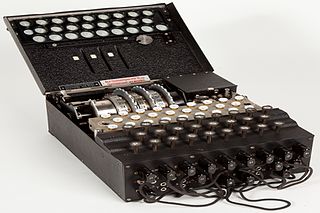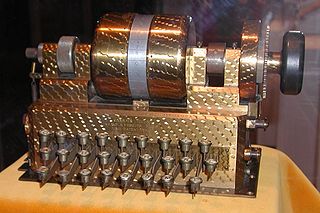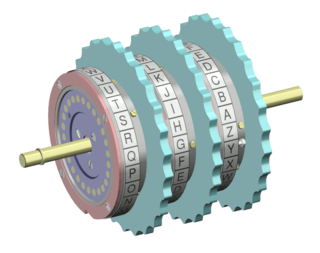
The Enigma machine is a cipher device developed and used in the early- to mid-20th century to protect commercial, diplomatic, and military communication. It was employed extensively by Nazi Germany during World War II, in all branches of the German military. The Enigma machine was considered so secure that it was used to encipher the most top-secret messages.

In the history of cryptography, Typex machines were British cipher machines used from 1937. It was an adaptation of the commercial German Enigma with a number of enhancements that greatly increased its security. The cipher machine was used until the mid-1950s when other more modern military encryption systems came into use.

In the history of cryptography, the "System 97 Typewriter for European Characters" or "Type B Cipher Machine", codenamed Purple by the United States, was an encryption machine used by the Japanese Foreign Office from February 1939 to the end of World War II. The machine was an electromechanical device that used stepping-switches to encrypt the most sensitive diplomatic traffic. All messages were written in the 26-letter English alphabet, which was commonly used for telegraphy. Any Japanese text had to be transliterated or coded. The 26-letters were separated using a plug board into two groups, of six and twenty letters respectively. The letters in the sixes group were scrambled using a 6 × 25 substitution table, while letters in the twenties group were more thoroughly scrambled using three successive 20 × 25 substitution tables.

In the history of cryptography, the ECM Mark II was a cipher machine used by the United States for message encryption from World War II until the 1950s. The machine was also known as the SIGABA or Converter M-134 by the Army, or CSP-888/889 by the Navy, and a modified Navy version was termed the CSP-2900.

The Hebern Rotor Machine was an electro-mechanical encryption machine built by combining the mechanical parts of a standard typewriter with the electrical parts of an electric typewriter, connecting the two through a scrambler. It is the first example of a class of machines known as rotor machines that would become the primary form of encryption during World War II and for some time after, and which included such famous examples as the German Enigma.

In cryptography, a rotor machine is an electro-mechanical stream cipher device used for encrypting and decrypting messages. Rotor machines were the cryptographic state-of-the-art for much of the 20th century; they were in widespread use in the 1920s–1970s. The most famous example is the German Enigma machine, the output of which was deciphered by the Allies during World War II, producing intelligence code-named Ultra.
Articles related to cryptography include:

The bombe was an electro-mechanical device used by British cryptologists to help decipher German Enigma-machine-encrypted secret messages during World War II. The US Navy and US Army later produced their own machines to the same functional specification, albeit engineered differently both from each other and from Polish and British bombes.

The bomba, or bomba kryptologiczna, was a special-purpose machine designed around October 1938 by Polish Cipher Bureau cryptologist Marian Rejewski to break German Enigma-machine ciphers.

Cryptanalysis of the Enigma ciphering system enabled the western Allies in World War II to read substantial amounts of Morse-coded radio communications of the Axis powers that had been enciphered using Enigma machines. This yielded military intelligence which, along with that from other decrypted Axis radio and teleprinter transmissions, was given the codename Ultra.

The method of Zygalski sheets was a cryptologic technique used by the Polish Cipher Bureau before and during World War II, and during the war also by British cryptologists at Bletchley Park, to decrypt messages enciphered on German Enigma machines.

The TSEC/KL-7, also known as Adonis was an off-line non-reciprocal rotor encryption machine. The KL-7 had rotors to encrypt the text, most of which moved in a complex pattern, controlled by notched rings. The non-moving rotor was fourth from the left of the stack. The KL-7 also encrypted the message indicator.
In the history of cryptography, the NEMA (NEue MAschine) ("new machine"), also designated the T-D (Tasten-Druecker-Maschine) ("key-stroke machine"), was a 10-wheel rotor machine designed by the Swiss Army during the World War II as a replacement for their Enigma machines.
This article contains technical details about the rotors of the Enigma machine. Understanding the way the machine encrypts requires taking into account the current position of each rotor, the ring setting and its internal wiring.

The cyclometer was a cryptologic device designed, "probably in 1934 or 1935," by Marian Rejewski of the Polish Cipher Bureau's German section (BS-4), to catalog the cycle structure of Enigma permutations, thereby facilitating the decryption of German Enigma ciphertext.
In cryptography, the clock was a method devised by Polish mathematician-cryptologist Jerzy Różycki, at the Polish General Staff's Cipher Bureau, to facilitate decrypting German Enigma ciphers. The method determined the rightmost rotor in the German Enigma by exploiting the different turnover positions. For the Poles, learning the rightmost rotor reduced the rotor-order search space by a factor of 3. The British improved the method, and it allowed them to use their limited number of bombes more effectively.
The card catalog, or "catalog of characteristics," in cryptography, was a system designed by Polish Cipher Bureau mathematician-cryptologist Marian Rejewski, and first completed about 1935 or 1936, to facilitate decrypting German Enigma ciphers.
The grill method, in cryptology, was a method used chiefly early on, before the advent of the cyclometer, by the mathematician-cryptologists of the Polish Cipher Bureau in decrypting German Enigma machine ciphers. The Enigma rotor cipher machine changes plaintext characters into cipher text using a different permutation for each character, and so implements a polyalphabetic substitution cipher.

A plugboard or control panel is an array of jacks or sockets into which patch cords can be inserted to complete an electrical circuit. Control panels are sometimes used to direct the operation of unit record equipment, cipher machines, and early computers. The array of holes is often contained in a flat removable panel that can be inserted into a machine and pressed against an array of contacts. This allows the machine to be quickly switched between different applications.

Marian Adam Rejewski was a Polish mathematician and cryptologist who in late 1932 reconstructed the sight-unseen German military Enigma cipher machine, aided by limited documents obtained by French military intelligence.

















